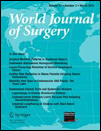Mortality Pattern in Surgical Wards of a University Teaching Hospital in Southwest Nigeria: A Review
Abstract
Background
There are many reports from different parts of the world addressing different aspects of surgical mortality. There are few reports from our country, however, and most of them have dealt with mortality in the emergency room. The aim of this study was to determine the prevalence of mortality associated with surgical care and the trends in prevalence of surgical mortality. We used our results as benchmarks to identify areas of improvement.
Methods
The records of all patients who died during admission for surgical care in Olabisi Onabanjo Teaching Hospital Sagamu between January 2006 and December 2010 were studied retrospectively. Relevant data were extracted, including demographics, surgical diagnosis, co-morbid conditions, length of hospital stay, surgical procedure performed, outcome of treatment, and date of death. Results were analyzed with Statistical Package for Social Sciences version 15.
Results
The total admission in the surgical wards for 2005–2010 was 5,444, with a total of 2,217 surgical operations carried out during the same period. There were 277 (5.09 %) deaths (165 male and 112 female patients). Of 277 deaths, only 170 case notes (61 %) were available for review. Primary causes of death were classified as cancer (50 deaths, 29.4 %), trauma (66, 38.8 %), infection/inflammatory (16, 9.4 %), and other (38, 22.4 %). Surgical operations were performed in 60 (35.3 %) of the patients who died. No surgery was done in 110 (64.7 %) of those who died.
Conclusions
The pattern of surgical mortality is not directly related to surgical procedures as most of the deaths occurred in the nonoperative care group. Trauma-associated deaths topped the list.




